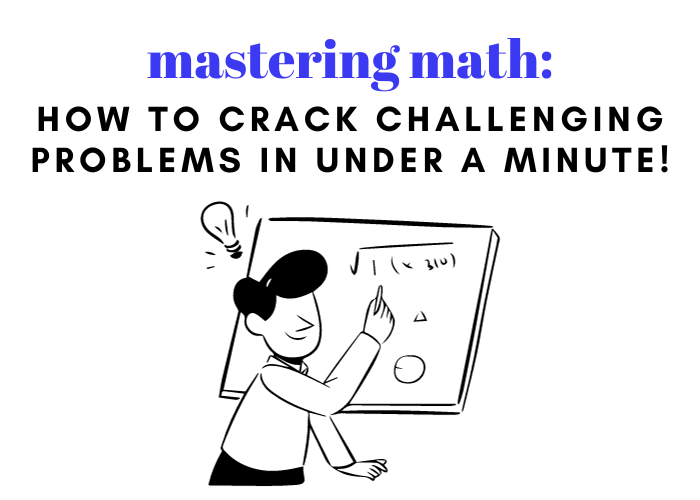

Last Updated on August 31, 2021 by Thinkster
You’ve probably noticed that your child’s education, especially when it comes to learning and excelling in math, is a full-fledged process with many steps and strategies.
Some are concrete ideas: practicing math word problems regularly, taking on extra math worksheets, or hiring a tutor. Others have to do with your student’s mindset, which we now know can be just as important as direct math practice.
Some students struggle with math concepts, and as you provide math homework help, encouraging the right mindset can take your student further when the going gets tough and they encounter harder math problems.
If your student can see the value in working through the problem, practicing, and improving, they’ll likely put more effort into it and become more confident.
At Thinkster, we believe in the concrete ideas mentioned above and in the value of a math app and online tutoring programs, but we also believe in the small things that can improve your child’s mathematical mind.
In this article, we’ve put together some ideas to help get your student in the right mindset for math homework help. Many of these things you can do at home with them on a daily basis, and they can be scaled up or down depending on the age and skill level of your child.
If you’re looking for that something extra, we invite you to read on.
Show Your Child How Math is Used in Daily Life
Some students may feel like math is unnecessary, and they don’t understand how they will ever use these skills in the future. So it’s important to show them how math is used in our everyday lives.
“Everything can have a connection to math, and math connects to everything,” as this article from Scholastic points out. The articles goes on to say that all thinking involves mathematics – even if we don’t always realize it. If you start looking for practical math ideas to share with your student, you’ll start to see them everywhere, too.
You can use skip-rope jumping or climbing stairs to practice counting, drawing to learn about geometry and science, and so on. The grocery store is a great place to use addition and subtraction, and recipes are perfect for talking about the use of fractions.
While getting dressed in the morning, you can talk about the the number of combinations you have for mixing and matching your pants and shirts that you could wear. Counting can be used when brushing teeth – to count the number of times they brush left to right or up and down. Getting kids comfortable with solving these kinds of problems in an informal way will help as they tackle similar problems and equations in school.
While you are looking for more ways to show your student that math is all around them, you will also see that there are many creative ways to give your student math homework help if they’re fighting against it. If your student finds regular math problems dry and unrealistic, try adding a little fun to engage them.
For example, let your student teach you what they learned that day in school or turn a math word problem into a short skit. Let them help you shop for and cook something based on a recipe. If your student is more competitive, turn math problems into speed trials or have them compete against you in math challenges. You can keep track of how well they do and use prizes as incentives. For the budding artist, use geometric concepts to give them ideas for drawings or challenge them to use a number of certain geometric shapes in an artistic piece.
The more fun your student has, the more engaged they will be in the work. They may even start to look forward to doing their math homework this way.
In a New York Magazine article from 2007, research showed how students respond to praise about how smart they are, and the results were somewhat surprising. Students who were praised for being smart did not put out as much effort on harder tests and gave up quicker than the students who were applauded for their effort when they struggled.
“Emphasizing effort gives a child a variable that they can control,” said psychologist Carol Dweck, who ran the study. “They come to see themselves as in control of their success. Emphasizing natural intelligence takes it out of the child’s control, and it provides no good recipe for responding to a failure.”
Whether your student has seen major growth through their math work or is still struggling, it’s important to give them praise that is sincere and will help them perform better. If they spent extra time on math worksheets or made huge strides while getting math homework help, praise their specific effort on that. Tell them that you are proud of the extra work they have been doing, and that you know it will pay off for them in the long run.
Just as important as praise is the ability to deal with failure. As parents, we often work hard to keep our students from experiencing failure and sometimes this does them a disservice as they don’t have the proper tools or strategies to deal with it.
Parents often want to ignore failure and insist their student will do better next time, but in the New York Magazine article referenced above, scholar Jennifer Crocker says this can lead children to believe that failure is something “so terrible, the family can’t acknowledge its existence.” Without the ability to discuss mistakes, your student can’t learn from them.
This article from the Child Mind Institute illustrates ways to help your child become a resilient adult through trial and error. Dr. Amanda Mintzer, a clinical psychologist at the Child Mind Institute, gives the following multi-step process for learning to fail in the article:
Failure is inevitable, but learning to deal with it early can be a great life skill that your student can use throughout their life.
When your child is struggling with learning a certain subject, it’s natural to want to push them to do better. This can have positive results when done the right way, but sometimes it can be better to let them take things at their own pace. Too much pressure can cause students to rush and stress over their math work, and this is not conducive to their efforts either.
The Scholastic article mentioned above explains it like this: “Encouraging your child to think mathematically at his own pace, rather than ‘rushing’ him or showing him how to solve a problem, is an excellent way to meet his need for creative intellectual activity.”
Everyone learns in different ways and at different rates. Allowing your student to learn on his or her own time, along with math homework help from you or a tutor, can provide that added layer of support they need to excel.
Using some of the tips above to sneak math into daily life can be a great way to prod them into math learning without them even realizing it or feeling any pressure. Freedom to learn in the way that is right for them can be great for their mathematical mind and mental well-being in general.
Another way to impact your child’s mindset in a way that is not directly related to math is to have them practice meditation and visualization. There has been a lot of research on the practice of meditation and visualization for success in many areas of life. Meditation can help calm the mind and lead to better focus and understanding, while visualization primes the brain for success.
According to this Forbes article, meditation and mindfulness can have the following benefits for kids that directly impact their time in the classroom and/or learning math at home:
The benefits of visualization have been seen with sports, and this can be carried over into classroom learning as well. The process involves creating a goal, visualizing yourself attaining that goal, and the acceptance of having what it is you are visualizing.
This can work for performing well on a specific test or doing better in class that day. It may seem silly, but encourage your student to give it a shot. You may be surprised by the results.
These are some great ways to get your student in the right mindset to tackle any math problem and tough concept they will come across in their math education journey. If you’re working on the mindset side, we also recommend the more concrete side of math help: math homework help through tutoring.
Our technology-enabled math tutoring program can be scaled to your student’s needs, and it even incorporates some of the tips above to make math fun and practical. We also have experienced math professionals available for one-on-one tutoring services for those who need more dedicated support.
We invite you to give our program a try for free through our 7-day trial now.


